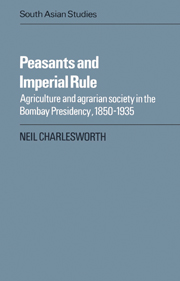Book contents
- Frontmatter
- Contents
- List of maps and tables
- Preface
- Note on technical terms and references
- Maps
- 1 Introduction: the peasant in India and Bombay Presidency
- 2 The village in 1850: land tenure, social structure and revenue policy
- 3 The village in 1850: land and agriculture
- 4 Indebtedness and the Deccan Riots of 1875
- 5 Continuity and change in the rural economy, 1850–1900
- 6 The Bombay peasantry, 1850–1900: social stability or social stratification?
- 7 The agricultural economy, 1900–1935: the critical watershed?
- 8 The impact of government policy, 1880–1935
- 9 The peasant and politics in the early twentieth century
- 10 Conclusions: the problem of differential commercialisation
- Glossary
- Bibliography
- Index
4 - Indebtedness and the Deccan Riots of 1875
Published online by Cambridge University Press: 10 December 2009
- Frontmatter
- Contents
- List of maps and tables
- Preface
- Note on technical terms and references
- Maps
- 1 Introduction: the peasant in India and Bombay Presidency
- 2 The village in 1850: land tenure, social structure and revenue policy
- 3 The village in 1850: land and agriculture
- 4 Indebtedness and the Deccan Riots of 1875
- 5 Continuity and change in the rural economy, 1850–1900
- 6 The Bombay peasantry, 1850–1900: social stability or social stratification?
- 7 The agricultural economy, 1900–1935: the critical watershed?
- 8 The impact of government policy, 1880–1935
- 9 The peasant and politics in the early twentieth century
- 10 Conclusions: the problem of differential commercialisation
- Glossary
- Bibliography
- Index
Summary
Our concern, in the last chapter, was predominantly with the credit system as an economic structure. Viewed in this light, it can emerge as a relatively sophisticated mechanism evolved to utilise such resources as were available to the mid-nineteenth-century village economy. However, the social implications were possibly far wider than yet considered. The very pervasiveness of the credit system throughout western Indian society meant that there were many different types of relationship, each with greatly varying potential consequences. Sometimes, where one party's ability to negotiate continued loans collapsed, the results might be dramatic. As we saw earlier, it was indisputable that many talukdari estates in Ahmedabad were being sold up cheaply for debt in the late 1850s and early 1860s. Here was the credit system – although wider issues of economic performance were also involved – unquestionably acting as an agent of social change. The Bombay government declared during the course of the rescue operations of 1862 that it wished to revive the talukdars' ‘ancient proprietary rights’ but ‘it is manifest that the object of Government would be entirely defeated … so long as the Talookdars are in debt’.
Social changes, like the decline of the Ahmedabad talukdars, were no novelty in western India and we have learnt to be much more sceptical about assuming that the beneficiaries in such cases were always new-comers to landownership and the status it conferred. Yet the fundamental issue concerns the frequency of such events by the middle of the nineteenth century.
- Type
- Chapter
- Information
- Peasants and Imperial RuleAgriculture and Agrarian Society in the Bombay Presidency 1850–1935, pp. 95 - 124Publisher: Cambridge University PressPrint publication year: 1985

